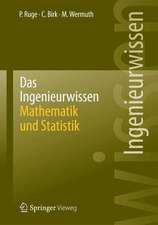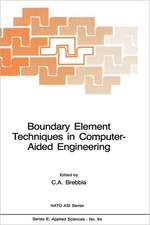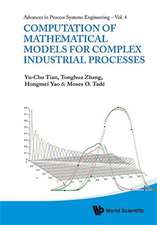Boundary Element Techniques: Theory and Applications in Engineering
Autor C. A. Brebbia, J. C. F. Telles, L. C. Wrobelen Limba Engleză Paperback – 19 apr 2012
Preț: 652.81 lei
Preț vechi: 768.01 lei
-15% Nou
Puncte Express: 979
Preț estimativ în valută:
124.93€ • 129.44$ • 104.26£
124.93€ • 129.44$ • 104.26£
Carte tipărită la comandă
Livrare economică 21 martie-04 aprilie
Preluare comenzi: 021 569.72.76
Specificații
ISBN-13: 9783642488627
ISBN-10: 3642488625
Pagini: 484
Ilustrații: XIV, 464 p.
Dimensiuni: 170 x 244 x 25 mm
Greutate: 0.76 kg
Ediția:Softcover reprint of the original 1st ed. 1984
Editura: Springer Berlin, Heidelberg
Colecția Springer
Locul publicării:Berlin, Heidelberg, Germany
ISBN-10: 3642488625
Pagini: 484
Ilustrații: XIV, 464 p.
Dimensiuni: 170 x 244 x 25 mm
Greutate: 0.76 kg
Ediția:Softcover reprint of the original 1st ed. 1984
Editura: Springer Berlin, Heidelberg
Colecția Springer
Locul publicării:Berlin, Heidelberg, Germany
Public țintă
Professional/practitionerCuprins
1 Approximate Methods.- 1.1. Introduction.- 1.2. Basic Definitions.- 1.3. Approximate Solutions.- 1.4. Method of Weighted Residuals.- 1.4.1. The Collocation Method.- 1.4.2. Method of Collocation by Subregions.- 1.5. Method of Galerkin.- 1.6. Weak Formulations.- 1.7. Inverse Problem and Boundary Solutions.- 1.8. Classification of Approximate Methods.- References.- 2 Potential Problems.- 2.1. Introduction.- 2.2. Elements of Potential Theory.- 2.3. Indirect Formulation.- 2.4. Direct Formulation.- 2.5. Boundary Element Method.- 2.6. Two-Dimensional Problems.- 2.6.1. Source Formulation.- 2.7. Poisson Equation.- 2.8. Subregions.- 2.9. Orthotropy and Anisotropy.- 2.10. Infinite Regions.- 2.11. Special Fundamental Solutions.- 2.12. Three-Dimensional Problems.- 2.13. Axisymmetric Problems.- 2.14. Axisymmetric Problems with Arbitrary Boundary Conditions.- 2.15. Nonlinear Materials and Boundary Conditions.- 2.15.1. Nonlinear Boundary Conditions.- References.- 3 Interpolation Functions.- 3.1. Introduction.- 3.2. Linear Elements for Two-Dimensional Problems.- 3.3. Quadratic and Higher-Order Elements.- 3.4. Boundary Elements for Three-Dimensional Problems.- 3.4.1. Quadrilateral Elements.- 3.4.2. Higher-Order Quadrilateral Elements.- 3.4.3. Lagrangian Quadrilateral Elements.- 3.4.4. Triangular Elements.- 3.4.5. Higher-Order Triangular Elements.- 3.5. Three-Dimensional Cell Elements.- 3.5.1. Tetrahedron.- 3.5.2. Cube.- 3.6. Discontinuous Boundary Elements.- 3.7. Order of Interpolation Functions.- References.- 4 Diffusion Problems.- 4.1. Introduction.- 4.2. Laplace Transforms.- 4.3. Coupled Boundary Element — Finite Difference Methods.- 4.4. Time-Dependent Fundamental Solutions.- 4.5. Two-Dimensional Problems.- 4.5.1. Constant Time Interpolation.- 4.5.2. Linear Time Interpolation.-4.5.3. Quadratic Time Interpolation.- 4.5.4. Space Integration.- 4.6. Time-Marching Schemes.- 4.7. Three-Dimensional Problems.- 4.8. Axisymmetric Problems.- 4.9. Nonlinear Diffusion.- References.- 5 Elastostatics.- 5.1. Introduction to the Theory of Elasticity.- 5.1.1. Initial Stresses or Initial Strains.- 5.2. Fundamental Integral Statement.- 5.2.1. Somigliana Identity.- 5.3. Fundamental Solutions.- 5.4. Stresses at Internal Points.- 5.5. Boundary Integral Equation.- 5.6. Infinite and Semi-Infinite Regions.- 5.7. Numerical Implementation.- 5.8. Boundary Elements.- 5.9. System of Equations.- 5.10. Stresses and Displacements Inside the Body.- 5.11. Stresses on the Boundary.- 5.12. Surface Traction Discontinuities.- 5.13. Two-Dimensional Elasticity.- 5.14. Body Forces.- 5.14.1. Gravitational Loads.- 5.14.2. Centrifugal Load.- 5.14.3. Thermal Loading.- 5.15. Axisymmetric Problems.- 5.15.1. Extension to Nonaxisymmetric Boundary Values.- 5.16. Anisotropy.- References.- 6 Boundary Integral Formulation for Inelastic Problems.- 6.1. Introduction.- 6.2. Inelastic Behavior of Materials.- 6.3. Governing Equations.- 6.4. Boundary Integral Formulation.- 6.5. Internal Stresses.- 6.6. Alternative Boundary Element Formulations.- 6.6.1. Initial Strain.- 6.6.2. Initial Stress.- 6.6.3. Fictitious Tractions and Body Forces.- 6.7. Half-Plane Formulations.- 6.8. Spatial Discretization.- 6.9. Internal Cells.- 6.10. Axisymmetric Case.- References.- 7 Elastoplasticity.- 7.1. Introduction.- 7.2. Some Simple Elastoplastic Relations.- 7.3. Initial Strain: Numerical Solution Technique.- 7.3.1. Examples — Initial Strain Formulation.- 7.4. General Elastoplastic Stress-Strain Relations.- 7.5. Initial Stress: Outline of Solution Techniques.- 7.5.1. Examples: Kelvin Implementation.- 7.5.2. Examples:Half-Plane Implementation.- 7.6. Comparison with Finite Elements.- References.- 8 Other Nonlinear Material Problems.- 8.1. Introduction.- 8.2. Rate-Dependent Constitutive Equations.- 8.3. Solution Technique: Viscoplasticity.- 8.4. Examples: Time-Dependent Problems.- 8.5. No-Tension Materials.- References.- 9 Plate Bending.- 9.1. Introduction.- 9.2. Governing Equations.- 9.3. Integral Equations.- 9.3.1. Other Fundamental Solutions.- 9.4. Applications.- References.- 10 Wave Propagation Problems.- 10.1. Introduction.- 10.2. Three-Dimensional Water Wave Propagation Problems.- 10.3. Vertical Axisymmetric Bodies.- 10.4. Horizontal Cylinders of Arbitrary Section.- 10.5. Vertical Cylinders of Arbitrary Section.- 10.6. Transient Scalar Wave Equation.- 10.7. Three-Dimensional Problems: The Retarded Potential.- 10.8. Two-Dimensional Problems.- References.- 11 Vibrations.- 11.1. Introduction.- 11.2. Governing Equations.- 11.3. Time-Dependent Integral Formulation.- 11.4. Laplace Transform Formulation.- 11.5. Steady-State Elastodynamics.- 11.6. Free Vibrations.- References.- 12 Further Applications in Fluid Mechanics.- 12.1. Introduction.- 12.2. Transient Groundwater Flow.- 12.3. Moving Interface Problems.- 12.4. Axisymmetric Bodies in Cross Flow.- 12.5. Slow Viscous Flow (Stokes Flow).- 12.6. General Viscous Flow.- 12.6.1. Steady Problems.- 12.6.2. Transient Problems.- References.- 13 Coupling of Boundary Elements with Other Methods.- 13.1. Introduction.- 13.2. Coupling of Finite Element and Boundary Element Solutions.- 13.2.1. The Energy Approach.- 13.3. Alternative Approach.- 13.4. Internal Fluid Problems.- 13.4.1. Free-Surface Boundary Condition.- 13.4.2. Extension to Compressible Fluid.- 13.5. Approximate Boundary Elements.- 13.6. Approximate Finite Elements.- References.- 14 Computer Program for Two-Dimensional Elastostatics.- 14.1. Introduction.- 14.2. Main Program and Data Structure.- 14.3. Subroutine INPUT.- 14.4. Subroutine MATRX.- 14.5. Subroutine FUNC.- 14.6. Subroutine SLNPD.- 14.7. Subroutine OUTPT.- 14.8. Subroutine FENC.- 14.9. Examples.- 14.9.1. Square Plate.- 14.9.2. Cylindrical Cavity Problem.- References.- Appendix A Numerical Integration Formulas.- A.1. Introduction.- A.2. Standard Gaussian Quadrature.- A.2.1. One-Dimensional Quadrature.- A.2.2. Two- and Three-Dimensional Quadrature for Rectangles and Rectangular Hexahedra.- A.2.3. Triangular Domain.- A.3. Computation of Singular Integrals.- A.3.1. One-Dimensional Logarithmic Gaussian Quadrature Formulas.- A.3.3. Numerical Evaluation of Cauchy Principal Values.- References.- Appendix B Semi-Infinite Fundamental Solutions.- B.1. Half-Space.- B.2. Half-Plane.- References.- Appendix C Some Particular Expressions for Two-Dimensional Inelastic Problems.






















